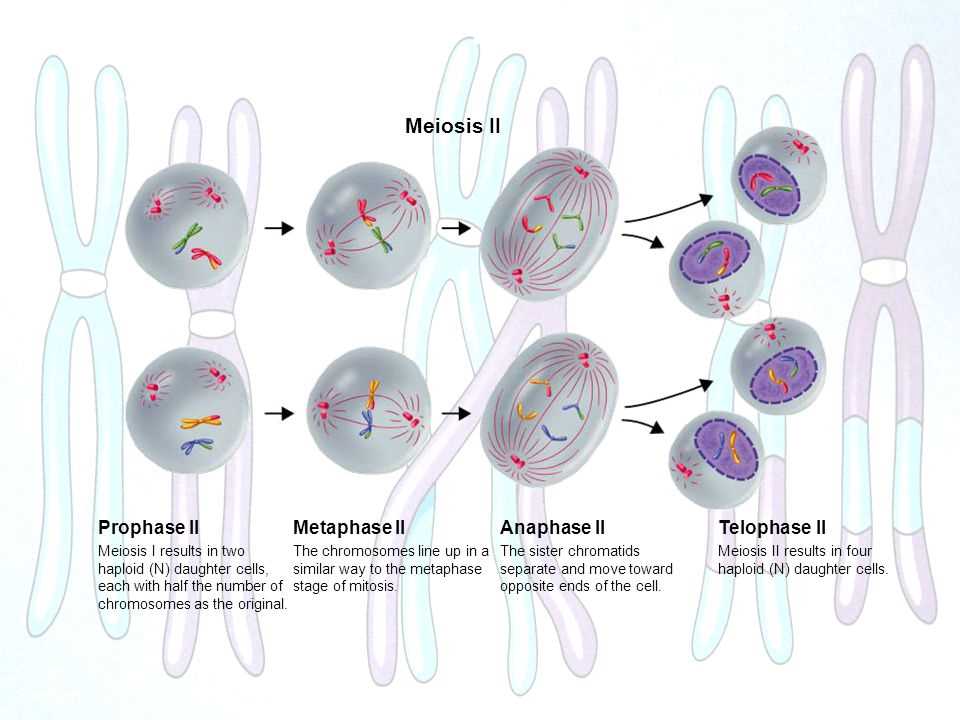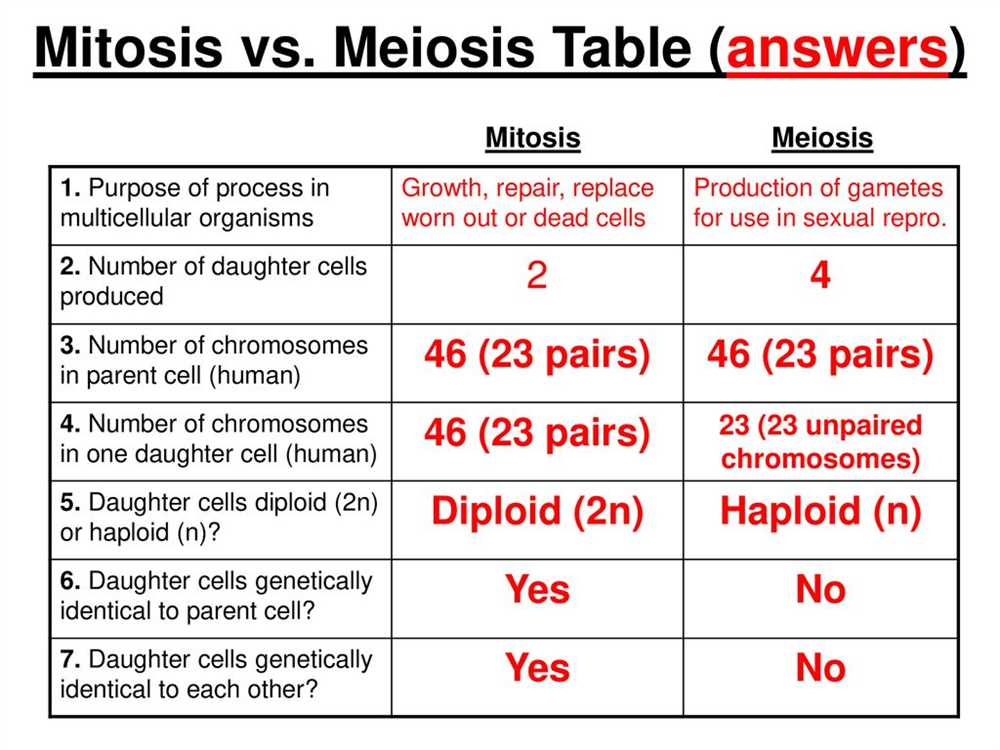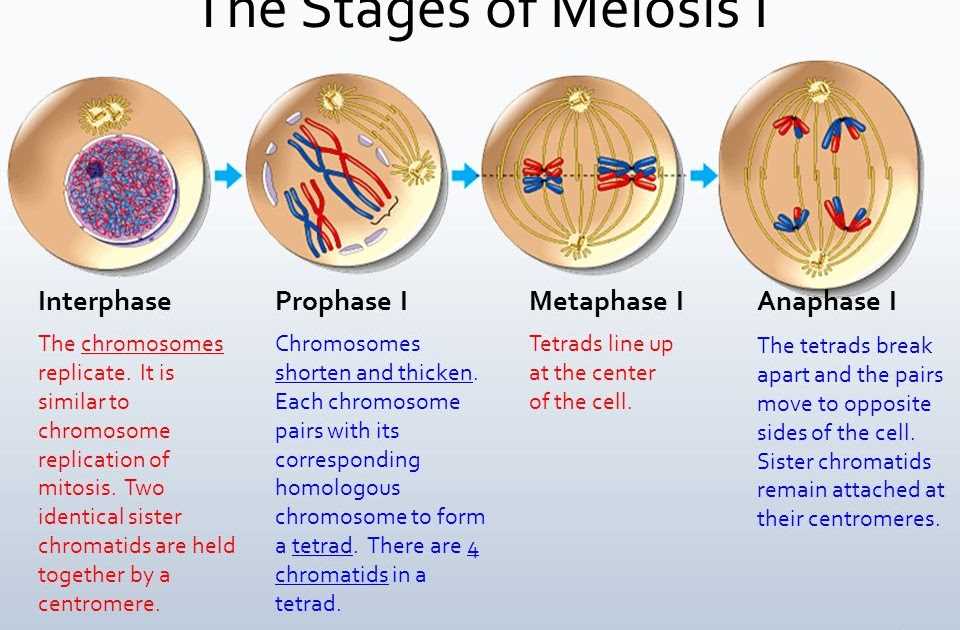
Meiosis is a crucial process that occurs in sexually reproducing organisms to produce gametes, or sex cells, with half the number of chromosomes as the parent cell. This unique division process ensures genetic diversity and plays a vital role in the continuation of life.
In this article, we will delve into the intricacies of meiosis and provide comprehensive answers to 11 commonly asked questions about this cellular process. From understanding the stages of meiosis to exploring the significance of crossing over, we’ll cover it all.
Starting with the basics, we’ll explain the difference between meiosis I and meiosis II, and how they contribute to the production of haploid cells. We’ll also discuss the importance of homologous chromosomes and their behavior during meiosis.
Furthermore, we’ll delve into the significance of meiotic recombination and how it leads to genetic variation among offspring. We’ll explore the consequences of errors in meiosis, such as non-disjunction, and their potential implications for the health and development of an organism.
Whether you’re a student studying genetics, a curious individual seeking to expand your knowledge, or simply interested in the wonders of life, this article will provide you with the answers you need to better understand the fascinating process of meiosis.
4 Meiosis Answers
Meiosis is the process of cell division that occurs in reproductive cells to produce gametes, such as eggs and sperm. This process involves two rounds of division, known as meiosis I and meiosis II, resulting in the formation of four haploid cells. Here are four key answers about meiosis:
1. What is the purpose of meiosis?
The purpose of meiosis is to reduce the number of chromosomes in reproductive cells by half. This is important for sexual reproduction because when gametes fuse during fertilization, they will restore the full chromosome number. Meiosis ensures genetic diversity and variation in offspring.
2. How does meiosis differ from mitosis?
Meiosis differs from mitosis in several ways. Firstly, meiosis involves two rounds of division, while mitosis involves only one round. Secondly, meiosis produces four haploid cells with half the number of chromosomes, while mitosis produces two diploid cells with the same number of chromosomes as the parent cell.
3. What is crossing over?
During meiosis, crossing over occurs during prophase I of meiosis I. It is a process where homologous chromosomes exchange genetic material, resulting in new combinations of alleles. Crossing over increases genetic variation and contributes to the uniqueness of each individual.
4. What is the significance of meiosis in sexual reproduction?
Meiosis is crucial for sexual reproduction as it allows for the creation of gametes with genetic diversity. This genetic diversity is essential for the survival of a species, as it increases the chances of offspring inheriting beneficial traits and adaptability to different environments. Meiosis also ensures the proper number of chromosomes is maintained in each generation.
Overall, meiosis plays a vital role in sexual reproduction by producing genetically diverse gametes and ensuring the correct chromosome number in offspring. It allows for the inheritance of unique combinations of genetic material, leading to increased diversity and adaptability in populations.
What is Meiosis?
Meiosis is a type of cell division that occurs in sexually reproducing organisms. It involves the production of gametes, or sex cells, which have half the number of chromosomes as the parent cell. This process is essential for sexual reproduction as it allows for the formation of genetic variation.
During meiosis, a cell undergoes two rounds of division, resulting in four daughter cells. These daughter cells are genetically different from the parent cell and from each other. The first round of division, called meiosis I, involves the separation of homologous chromosomes, while the second round, meiosis II, involves the separation of sister chromatids.
Meiosis is responsible for the creation of genetic diversity. Through processes such as crossing over and independent assortment, the genetic material is shuffled and recombined, resulting in the production of gametes with unique combinations of genes. This genetic variation is crucial for the adaptation and evolution of species.
Meiosis plays a vital role in the life cycle of sexually reproducing organisms. It ensures that the number of chromosomes is halved in the gametes, allowing for the fusion of two gametes during fertilization to restore the original number of chromosomes in the offspring. This process also helps maintain the stability of the species by preventing the accumulation of too many chromosomes over generations.
In summary, meiosis is a specialized form of cell division that produces gametes with half the number of chromosomes as the parent cell. It generates genetic variation through processes like crossing over and independent assortment and is essential for sexual reproduction and the evolution of species.
The Stages of Meiosis

Meiosis is the process of cell division that produces gametes, or reproductive cells, in sexually reproducing organisms. It involves two rounds of division: meiosis I and meiosis II. Each round of division consists of several distinct stages.
The first stage of meiosis I is called prophase I. During this stage, the chromosomes condense and become visible. Homologous chromosomes pair up and exchange genetic material in a process called crossing over. This genetic recombination contributes to genetic variation in offspring. The nuclear membrane also breaks down during prophase I.
The second stage of meiosis I is metaphase I. During this stage, the paired homologous chromosomes align along the center of the cell. The spindle fibers attach to the centromeres of each pair of chromosomes, ensuring they are properly aligned for division.
Next, the cell enters anaphase I, where the homologous chromosomes are pulled apart by the spindle fibers. Each chromosome moves towards opposite ends of the cell, ensuring that each daughter cell will receive one copy of each chromosome.
The final stage of meiosis I is telophase I. During this stage, the chromosomes arrive at the opposite poles of the cell and the nuclear membrane starts to reform. The cell then undergoes cytokinesis, or the division of the cytoplasm, resulting in two haploid cells.
Meiosis II then follows, which is similar to mitosis. It consists of prophase II, metaphase II, anaphase II, and telophase II. The main difference is that the chromosomes do not pair up in meiosis II, and the resulting cells are haploid rather than diploid.
In conclusion, meiosis is a crucial process in sexual reproduction that leads to the formation of genetically diverse gametes. Understanding the stages of meiosis is important in comprehending the complexities of genetic inheritance and variation.
Meiosis vs. Mitosis
Meiosis and mitosis are two different types of cell division processes that occur in organisms. While both processes involve the division of cells, they have distinct differences in terms of their purpose, stages, and outcomes.
Purpose: Meiosis is a specialized form of cell division that occurs in the cells that give rise to eggs and sperm, also known as gametes. Its purpose is to produce genetically unique cells with half the number of chromosomes as the parent cell. On the other hand, mitosis is a type of cell division that occurs in somatic cells, which are all the other cells in the body, with the purpose of growth, repair, and maintenance of the organism.
Stages: Meiosis consists of two rounds of division, known as meiosis I and meiosis II. In meiosis I, the homologous chromosomes pair up, exchange genetic material through a process called crossing over, and separate into two daughter cells. In meiosis II, the sister chromatids separate, resulting in four haploid daughter cells with unique combinations of genetic material. In contrast, mitosis consists of only one round of division, where the sister chromatids separate, resulting in two identical daughter cells with the same number of chromosomes as the parent cell.
Outcomes: The outcome of meiosis is the production of genetically diverse sex cells (gametes) with half the number of chromosomes as the parent cell. This is crucial for sexual reproduction and the creation of offspring with unique combinations of genetic material. In contrast, mitosis results in the production of genetically identical cells that have the same number of chromosomes as the parent cell. This is important for growth, repair, and maintenance of the organism.
In summary, meiosis and mitosis are two different types of cell division processes with distinct purposes, stages, and outcomes. Meiosis is involved in the production of gametes for sexual reproduction, while mitosis is responsible for growth, repair, and maintenance of an organism. Understanding these differences is crucial for comprehending the complex processes that occur within living organisms.
Importance of Meiosis

Meiosis is a vital process in the life cycle of sexually reproducing organisms. It plays a crucial role in the production of gametes, which are necessary for sexual reproduction. Meiosis ensures genetic diversity by creating cells with unique combinations of genetic material, which is essential for the survival and adaptation of species.
Inheritance of genetic information: Meiosis is responsible for the shuffling and distribution of genetic material from parent cells to offspring. During meiosis, homologous chromosomes pair up and exchange segments of their DNA through a process called crossing over. This results in genetic recombination, leading to the formation of genetically diverse gametes. This diversity allows for the combination of different genetic traits in offspring, increasing the potential for adaptation and survival in changing environments.
Maintenance of chromosome number: Meiosis ensures that the number of chromosomes is halved in gametes by undergoing two rounds of cell division. This reduction in chromosome number is important because when gametes fuse during fertilization, the resulting zygote will have a complete set of chromosomes. Without meiosis, the fusion of gametes would result in a doubling of chromosome number with each generation, eventually leading to an unviable organism.
Prevention of genetic abnormalities: Meiosis includes crucial checkpoints and mechanisms that help prevent the transmission of genetic abnormalities. These mechanisms, such as homologous chromosome pairing and segregation, ensure that the correct number of chromosomes is distributed evenly to gametes. Errors in meiosis can lead to aneuploidy, which is the presence of an abnormal number of chromosomes in a cell, and can result in genetic disorders like Down syndrome.
Overall, meiosis is essential for the production of gametes, genetic diversity, maintenance of chromosome number, and prevention of genetic abnormalities. It is a fundamental process that allows sexually reproducing organisms to ensure the survival and adaptation of their species.
Meiosis in Humans
In humans, meiosis is a specialized cell division process that occurs in the reproductive cells, also known as gametes. Gametes are sperm cells in males and egg cells in females, and they are responsible for carrying the genetic material from one generation to the next. Meiosis involves two rounds of division, known as meiosis I and meiosis II, which ultimately results in the production of four haploid cells.
Meiosis I: During meiosis I, the homologous chromosomes pair up and exchange genetic material in a process called crossing over. This genetic recombination allows for the shuffling of genetic traits and promotes genetic diversity. After crossing over, the homologous chromosomes separate, with one chromosome from each pair going to each of the two daughter cells. Each daughter cell now has one complete set of chromosomes, but each chromosome is still composed of two sister chromatids.
Meiosis II: Meiosis II is similar to mitosis, as it involves the separation of sister chromatids. The two daughter cells from meiosis I undergo further division, resulting in the production of four haploid cells. Each of these cells contains a unique combination of genetic material due to crossing over during meiosis I and independent assortment during meiosis II.
Meiosis is a crucial process for sexual reproduction in humans, as it ensures that each gamete receives a unique combination of genetic material from both parents. This genetic diversity is important for the survival of a species, as it allows for adaptation to changing environments and helps prevent the accumulation of harmful mutations.
Common Questions about Meiosis
Meiosis is a crucial process in the life cycle of sexually reproducing organisms, including plants and animals. It involves the division of cells to produce gametes, which are essential for sexual reproduction. Here are some common questions about meiosis that people often have:
1. What is the purpose of meiosis?
Meiosis is responsible for the production of haploid cells, such as sperm and eggs, which contain half the number of chromosomes as the parent cells. This is important for sexual reproduction because when the sperm and egg fuse during fertilization, the resulting offspring will have the right amount of genetic material.
2. How does meiosis differ from mitosis?
Meiosis differs from mitosis, another type of cell division, in several ways. While mitosis results in the formation of two identical diploid cells, meiosis involves two rounds of division that produce four non-identical haploid cells. Meiosis also undergoes a process called crossing over, where genetic material is exchanged between homologous chromosomes, increasing genetic diversity.
3. When does meiosis occur?
Meiosis occurs during the formation of gametes, which happens at different times in different organisms. In humans, for example, meiosis occurs in the cells that give rise to sperm or eggs during puberty. In plants, meiosis takes place in the cells that produce pollen or ovules.
4. What are the stages of meiosis?
Meiosis consists of two main stages: meiosis I and meiosis II. In meiosis I, homologous chromosomes pair up and exchange genetic material through crossing over. The cell then divides, resulting in two cells with a unique combination of chromosomes. In meiosis II, the two cells from meiosis I divide again, resulting in a total of four non-identical haploid cells.
5. Why is meiosis important for genetic diversity?
Meiosis plays a crucial role in generating genetic diversity within populations. Through the process of crossing over and independent assortment of chromosomes, new combinations of genetic material are created in the offspring. This genetic variation is important for the survival and adaptation of species in changing environments.
Overall, meiosis is a complex and essential process that allows for the production of genetically diverse gametes, ensuring the continuation of life through sexual reproduction.